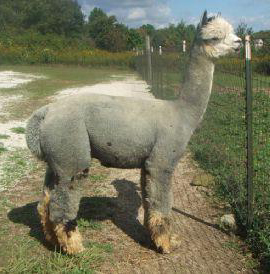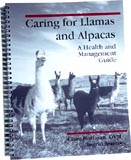Do bad things happen in threes? A lot of people seem to think so. In the course of human events, that certainly seemed to hold true this past week, when celebrity news was dominated by the deaths of Ed McMahon, Farrah Fawcett, and Michael Jackson. Just like that, one shocking passing after another.
It caused me to think about the tough year we’ve had for alpaca herdsire deaths. Starting with the end of 2008, some big name males have passed on. Some at an age where you might expect it, but others shockingly taken before their time, when their potential was just being explored.
Here’s to some of those males , who I hope are enjoying green pastures in alpaca valhalla.
It would be hard to come up with a list of herdsires who have had a greater impact on the American alpaca population than Legacy. Perhaps the most important passing of an alpaca stud since Caligula, Legacy made news late in his life when half interest in him was sold for $750,000. Born in 1991, his genetics are widespread throughout the alpaca population and it has yet to be seen which of his sons will equal his accomplishments.
Legacy was owned by Crescent Moon Ranch and Virginia Alpaca Farm.
AML Legacy’s El Duro (Pedro)
Tragically, one of Legacy’s most well-known sons passed away shortly after him at just six and a half years of age. The male retained by Alpacas of Maple Lane to replace Legacy when they sold him, Pedro (as he was commonly known) made his mark by producing such outstanding offspring as AML El Duro’s Principio.
Pedro was owned by Gore Mountain Farm and Alpacas of Maple Lane.
It is always our goal as breeders to produce animals that exceed the previous generation. In reality, though, it’s much harder than it sounds. So when you have a son out of as potent a male as Caligula that succeeds in establishing himself as his own name brand, you know you have a very special male indeed. When most people hear El Nino, there is no suffix such as “son of Caligula” following. People know the name, just as they know the pedigree. Ten years old when he died, El Nino left behind a multitude of sons to carry on his legacy, including seven active working sons at his owner’s.
El Nino was owned by Pacific Crest Alpacas.
AofO Silver Celebration
The biggest shocker of all, Silver Celebration was just five years old when he passed away at the end of 2008. Probably the winningest silver grey male ever, he won a total of 21 banners and 23 blue ribbons, with an elite fleece style that was shocking for its approximation to the quality of white. At his young age, the alpaca industry was still waiting to see if he could consistently replicate his quality and take his place among the greats. Now we’ll never know.
Silver Celebration was owned by Alpacas of Ohio and Hilltop Alpacas.







